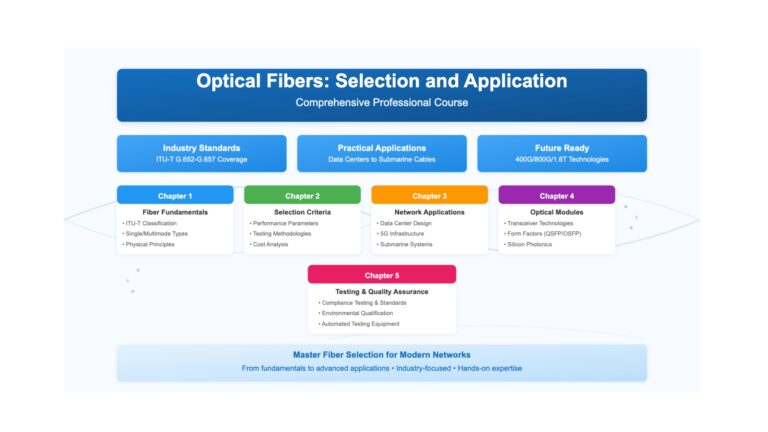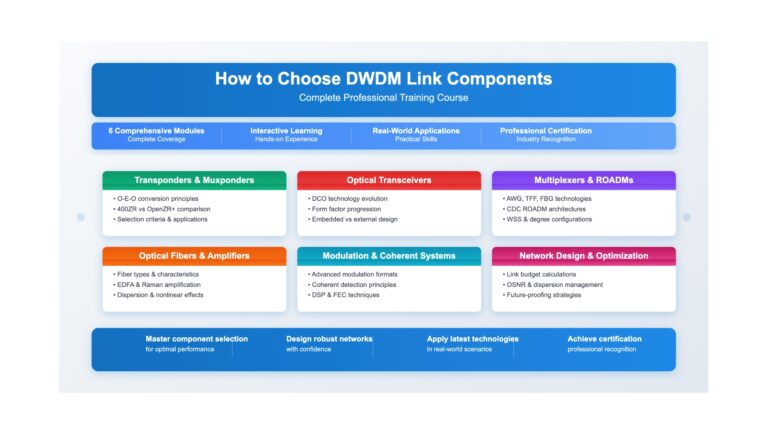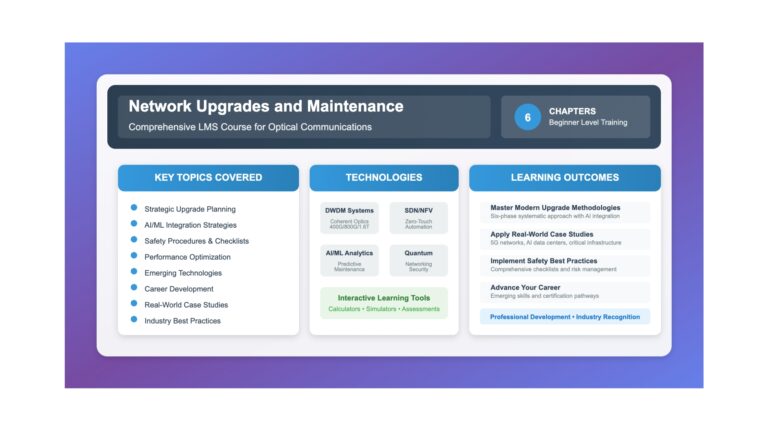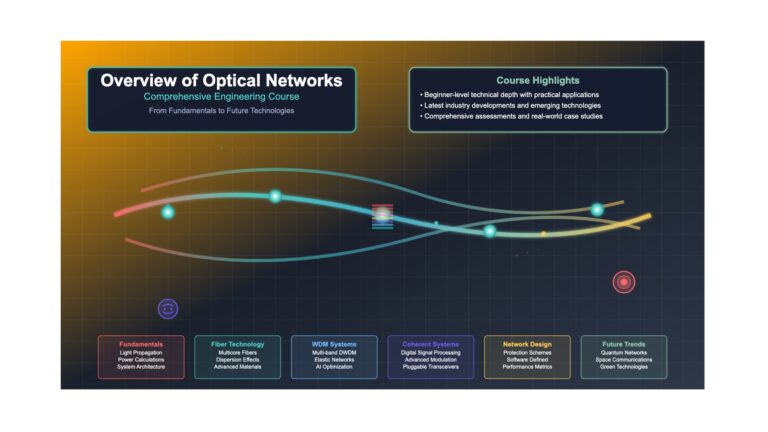Description
Curriculum
Instructor
Learning Objectives
- Understand the fundamental principles and evolution of Dense Wavelength Division Multiplexing (DWDM)
- Analyze current market trends and industry drivers shaping DWDM deployment in 2024-2025
- Compare DWDM technology with other multiplexing techniques and identify optimal use cases
- Evaluate the impact of emerging technologies like 5G, AI, and edge computing on DWDM requirements
- Assess the economic and technical benefits of DWDM in modern telecommunications infrastructure
Curriculum
- 6 Sections
- 53 Lessons
- 10 Weeks
Expand all sectionsCollapse all sections
- Chapter 1: Introduction to DWDM Technology and Market Landscape8
- 1.11.1 Introduction to DWDM Technology
- 1.21.2 Current Market Landscape and Industry Drivers
- 1.31.3 DWDM Technology Evolution Timeline
- 1.41.4 DWDM vs. Other Multiplexing Technologies
- 1.51.5 Economic Benefits and ROI Considerations
- 1.61.6 Industry Applications and Use Cases
- 1.71.7 Emerging Trends and Future Outlook
- 1.8Knowledge Check
- Chapter 2: DWDM System Architecture and Components8
- Chapter 3: Optical Transmission Fundamentals and ITU Standards10
- 3.13.1 Optical Fiber Transmission Windows
- 3.23.2 ITU-T Grid Standards and Channel Planning
- 3.33.3 Chromatic Dispersion
- 3.43.4 Polarization Mode Dispersion (PMD)
- 3.53.5 Nonlinear Effects in DWDM Systems
- 3.63.6 Optical Signal-to-Noise Ratio (OSNR)
- 3.73.7 Advanced Fiber Types and Characteristics
- 3.83.8 System Performance Modeling
- 3.93.9 Emerging Standards and Technologies
- 3.10Knowledge Check
- Chapter 4: Coherent Optics and Advanced Modulation Formats9
- 4.14.1 Coherent Detection Fundamentals
- 4.24.2 Advanced Modulation Formats
- 4.34.3 Digital Signal Processing (DSP) Algorithms
- 4.44.4 Industry Standards: 400ZR and OpenZR+
- 4.54.5 Next-Generation Coherent Technologies
- 4.64.6 System Performance Optimization
- 4.74.7 Practical Implementation Considerations
- 4.84.8 Future Coherent Technologies
- 4.9Knowledge Check
- Chapter 5: DWDM Network Design and Engineering9
- 5.15.1 Network Design Methodology
- 5.25.2 Link Budget Engineering
- 5.35.3 Network Topologies and Design Trade-offs
- 5.45.4 Protection and Restoration Schemes
- 5.55.5 ROADM Design and Optimization
- 5.65.6 Network Monitoring and Management
- 5.75.7 Troubleshooting and Optimization
- 5.85.8 Future Network Design Trends
- 5.9Knowledge Check
- Chapter 6: Next-Generation Technologies and Future Trends9
- 6.16.1 Beyond 400G: The Path to Terabit Transmission
- 6.26.2 Space-Division Multiplexing (SDM)
- 6.36.3 Quantum Communications and Security
- 6.46.4 AI and Machine Learning in Optical Networks
- 6.56.5 Sustainability and Green Networking
- 6.66.6 Technology Roadmap and Timeline
- 6.76.7 Emerging Applications and Use Cases
- 6.86.8 Challenges and Research Directions
- 6.9Knowledge Check
Admin

29 Students36 Courses
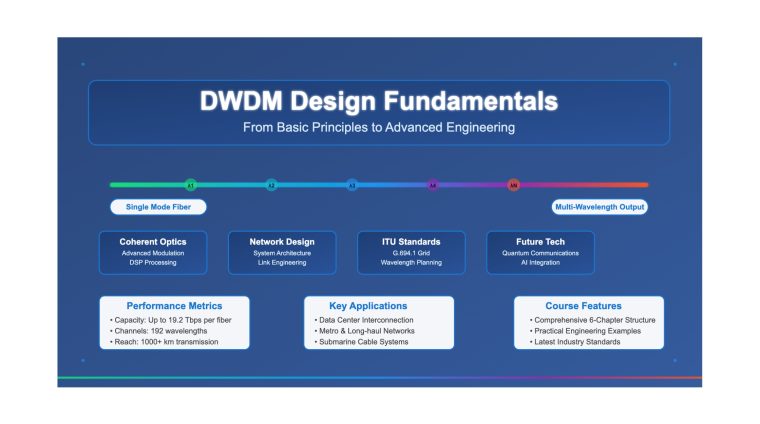
Free
0 student
53 lessons
Language: English
0 quiz
Assessments: Yes
Skill level All levels
Courses you might be interested in
Fiber Optics & Components
Learning Objectives Understand the fundamental principles of optical fiber communication and light propagation Classify different types of optical fibers based on ITU-T standards and industry specifications Analyze the key physical...
-
41 Lessons
Free
DWDM Technology
Learning Objectives Understand the fundamental principles of Dense Wavelength Division Multiplexing (DWDM) Analyze the role and functionality of transponders in DWDM networks Compare different transponder types and their applications Evaluate...
-
49 Lessons
Free
Network Automation
Learning Objectives Understand the fundamental principles and drivers of network upgrades in modern optical communications Analyze capacity requirements, technology advancements, and cost-benefit considerations for upgrade decisions Evaluate compatibility, interoperability, and...
-
47 Lessons
Free
DWDM Technology
Learning Objectives Understand the fundamental principles of optical communication and light propagation Analyze the electromagnetic spectrum and optical window characteristics for fiber transmission Compare optical communication advantages over traditional electrical...
-
61 Lessons
Free


